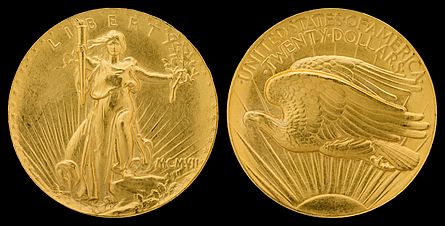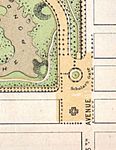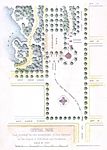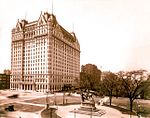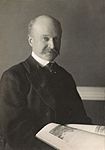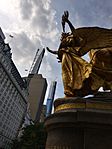William Tecumseh Sherman (Saint-Gaudens) facts for kids
Quick facts for kids William Tecumseh ShermanVictory |
|
|---|---|
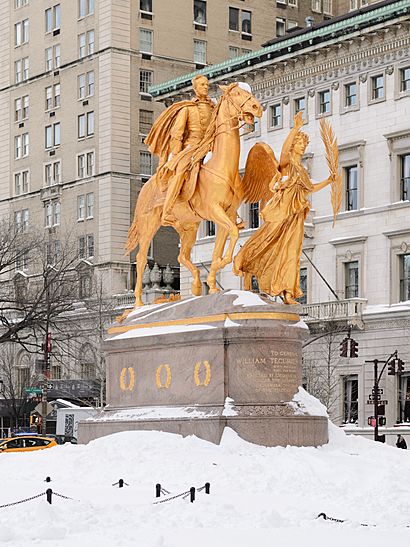
The sculptures in 2016
|
|
| Artist | Augustus Saint-Gaudens |
| Year | 1902 |
| Type | Sculpture |
| Medium | Bronze |
| Subject | William Tecumseh Sherman |
| Location | New York City, New York, U.S. |
| 40°45′52″N 73°58′24″W / 40.7645°N 73.9732°W | |
The William Tecumseh Sherman sculpture is also known as the Sherman Memorial or Sherman Monument. It honors William Tecumseh Sherman, a famous general. The artwork was created by Augustus Saint-Gaudens. You can find it at Grand Army Plaza in Manhattan, New York City.
This large monument was made in 1902 and officially shown to the public on May 30, 1903. It is made of bronze and covered in gold, which is called "gilded." The monument has two main parts. One is an equestrian statue of General Sherman, meaning he is shown riding a horse. The other part is a statue called Victory. This is a female figure that represents the Greek goddess Nike, who was the goddess of victory. Both statues stand on a strong stone base called a pedestal. This pedestal was designed by the architect Charles Follen McKim.
Contents
History of the Sherman Monument
Plaza Redesign and Statue Move in 1913
A newspaper owner named Joseph Pulitzer passed away in 1911. He left $50,000 in his will to build a special fountain. He wanted this fountain to look like the famous ones in Paris, France. In December 1912, the people in charge of Pulitzer's money announced the fountain's location. It would be in the plaza between 58th Street and 60th Street, near Fifth Avenue. This was the same plaza where the Sherman Monument had been since 1903.
Five architecture companies were asked to compete to design the fountain. They also had to plan how the whole plaza would look. In January 1913, the designs were shown at the New York Public Library. The winning design came from Carrère and Hastings. Their plan put the new fountain in the southern part of the plaza. The Sherman Monument stayed in the northern part. However, it was moved about 15 feet west. This made it line up perfectly with the new fountain.
Building the new plaza started in 1915. By November, a newspaper reported that the Pulitzer Fountain was finished. It was "bubbling with the purest Croton water." The newspaper also noted that work on the northern part of the plaza was slower. This was because of subway construction happening nearby.
Becoming a Landmark in 1974
On May 30, 1974, an important group called the Landmarks Preservation Commission held a meeting. They wanted to make Grand Army Plaza, including the Sherman Monument, a "Scenic Landmark." This means it's a special place that needs to be protected because of its history and beauty. The plan was approved on July 23, 1974.
Restoration Work from 1985 to 1990
On March 26, 1985, two groups, the Central Park Conservancy and Buttrick White & Burtis, showed their plans. They wanted to completely fix up the plaza and the Sherman Monument. They presented these plans to the Landmarks Preservation Commission. The restoration work was finished in June 1990. During this time, the statue was covered in new gold leaf, a process called "re-gilding." Also, a palm frond (a leaf) and a sword that had been missing from the statue were replaced.
Another Restoration in 2013
The Grand Army Plaza got another update in 2013. As part of this work, the statue of William Tecumseh Sherman was re-gilded again. This helped keep its golden shine.
A Look at the Sculpture
A sculptor named John Quincy Adams Ward once shared his thoughts on the Sherman Monument. He felt that Saint-Gaudens, the artist, was not very good at riding horses. Ward joked that "if the horse should stumble the general would inevitably be thrown over his head." This was his way of saying the horse's pose looked a bit unsteady.
Sherman Monument on Coins
The Victory statue from the Sherman Monument also inspired a famous coin. The front side of the 1907 United States Saint-Gaudens double eagle coin shows a figure of Liberty. This image was based on Saint-Gaudens' sculpture of Victory.
Gallery
See also
 In Spanish: William Tecumseh Sherman (Saint-Gaudens) para niños
In Spanish: William Tecumseh Sherman (Saint-Gaudens) para niños


